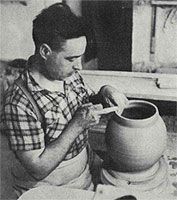
 Pierre Fouquet was born in Paris on November 4, 1909. After spending his childhood in the region of Albi, he returned to Paris at the age of 11, where he showed a talent for drawing at the Municipal School. This led him to enter the School of Applied Arts in 1923, where he studied for four years under masters like Chadel, Wlerick, and the ceramists Chabrier and Boéton.
Pierre Fouquet was born in Paris on November 4, 1909. After spending his childhood in the region of Albi, he returned to Paris at the age of 11, where he showed a talent for drawing at the Municipal School. This led him to enter the School of Applied Arts in 1923, where he studied for four years under masters like Chadel, Wlerick, and the ceramists Chabrier and Boéton.
He attended the Montparnasse Art School, where he studied modeling and prepared for teaching. He worked at a faience factory in Sceaux and later at Raoul Lachenal's studio. Returning to the Sceaux faience factory, he became a foreman and model creator. From 1929 to 1939, he held various positions in private industry, including working for Robj and Sauzéa workshops.
From 1939 to 1941, he worked in the decoration department of the Manufacture de Sèvres under the direction of Gensoli. In 1941, he was appointed professor of ceramics at the School of Applied Arts, where he organized workshops and teaching. In 1952, he became an auxiliary chief at the National Conservatory of Arts and Crafts, and since 1954, he has been a lecturer at the School of Applied Arts.
Since 1948, Pierre Fouquet has regularly exhibited at the Salon des Artistes Décorateurs and received the Plumet Prize there. At the International Exhibition in Florence, he was awarded a diploma of honor, and at the International Ceramic Exhibition in Cannes in the summer of 1955, he won a gold medal and one of the two prizes awarded to France: the prize for ceramic achievement.
Both the State and the City of Paris have acquired works by Pierre Fouquet. As a child, he observed potters at work and learned the discipline of a craft subject to regular demands. He retained a respect for well-executed work and enduring pieces fulfilling their purpose. He strives to impart these fundamental principles to his students.
In 1942, he established his workshops and built his kilns in Verrières-le-Buisson. Initially a faience maker, he gradually shifted his focus to high-temperature firing. As a knowledgeable and complete technician, Pierre Fouquet designs his forms, prepares his clays and glazes, turns his pieces, decorates them when necessary, and finally fires them in wood-burning kilns.
Influenced by the ancient Chinese and Korean potters, he follows in the footsteps of contemporary masters like Chaplet, Lenoble, and Decoeur, valuing the intrinsic beauty of the clay and glaze transformations under the action of fire more than elaborate decoration.
He emphasizes ample and simple forms, with extremely discreet decoration incorporated or incised into the clay and under the glaze, serving a complementary role. Using the fine translucency of porcelain and thin stoneware, he achieves white and satin tones, pink, ivory, and celadon. For natural stoneware in grey or red, he reserves robust tones of blue, green, bronze, black, and engobes, reminiscent of the ornamental possibilities of ancient Greek and Roman pottery.
Firing at 1280°C, Pierre Fouquet achieves dense, resonant, and impermeable pottery. Driven by his passion for his craft, he focuses solely on the material and aesthetic beauty of his creations, diligently pursuing their difficult realization in the peaceful atmosphere of his rustic workshop.
Sources : Mobilier et Decoration N° 9 Decembre 1955